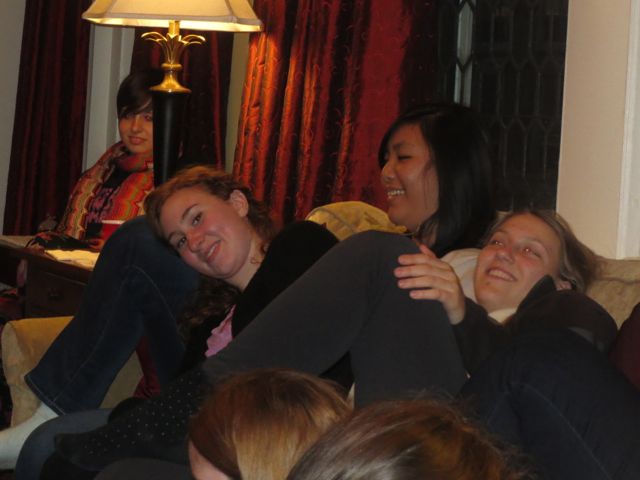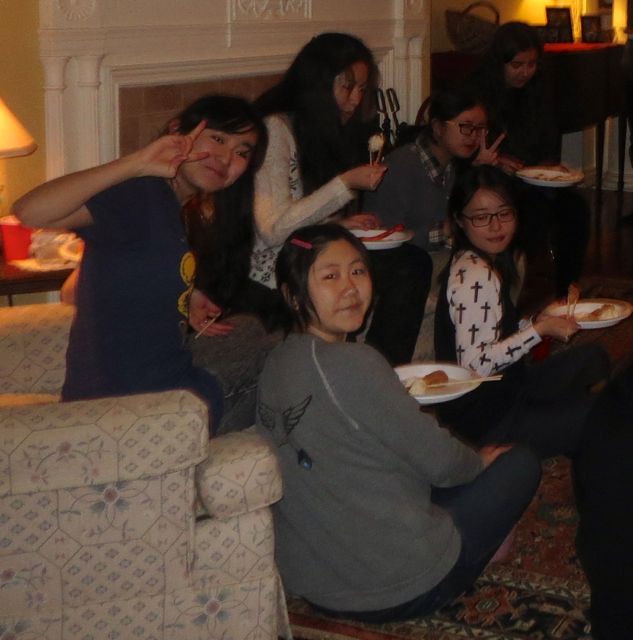Serendip is an independent site partnering with faculty at multiple colleges and universities around the world. Happy exploring!
2014 Tri-Co Environmental Studies Workshop: Welcoming Our Asian Students

Welcoming Our Asian Students (Anne Dalke)
Session IV @ the 2014 Tri-Co Environmental Studies Workshop
Yesterday morning, I started our session with an image of Harriet Tubman,
who, I think, represented the only black person in the room.
Looking around the room now, I see that the grand majority of us are Caucasian.
This, I posit, is not a healthy eco-system,
not a healthy eco-intellectual system,
because it/we are not very diverse.
The institutional whiteness of env’l studies,
as we all know, is a long-standing issue.
So--I’m going to talk for a few minutes now about the current
diversification (particularly the internationalization) of our student body.
I’m going to frame it first as a matter of ecological footprint (we do not have to go to Asia to “operate on the global stage”; Asia has come to us). I’m also going to invite you to think about the classroom as a complex
eco-system that requires multiple perspectives/points of view: claiming that it is not healthy or sustainable if it is monolingual, and that it should not be our goal to make it monocultural.
As it is not. In a recent faculty meeting focused on “internationalization,”
I learned that 26.5% of Bryn Mawr's current first year class (the class of 2017)
are international students; 17.8% of them are citizens of China.
International enrollments at U.S. colleges and universities
are at an all-time high, and are growing significantly;
some researchers predict that the international enrollments
at U.S. institutions may double by 2020, with Chinese students
continuing to be the largest group for a least a decade and likely longer.
The international students at Bryn Mawr have higher average SAT scores, higher GPA’s and better retention and graduation rates than do our U.S. students. For the past 4 years, 1/3 of the 14 students enrolled in each of my first-semester writing seminars have been from China, but my experience has not been one of engaging highly accomplished and high-performing students. At this point, newly arrived, these young women are finding the culture of America, and of American college, a real challenge:
* they are finding the reading difficult—
and there is generally far too much of it;
* they are finding the writing a challenge
(most have never written essays in English before);
hardest for me, though, has been the fact that
* they have a great deal of trouble following, much less contributing to,
the free-wheeling discussion in my classes--
something they have also never experienced before.
* A lot of students who have studied in other countries
“have a strong sense of the authority of the teacher.”
They find it difficult to look a teacher in the eye,
to ask a question, to push back or challenge—
much less to admit that they are having difficulties, feel lost…
To date, I have not felt @ all successful in “welcoming Asia” to Bryn Mawr.
Last December, my co-teacher and I hosted an end-of-semester lunch for our 28 first year students,
@ my apartment in Center City. We asked each one to describe her individual foray into the city;
not one of the Chinese students spoke to the group as a whole.







I told my co-teacher afterwards that we had failed, and he quipped that “14 weeks is not long enough to counter 1000s of years of cultural conditioning” (which, according to our ESL consultant, includes the belief that it’s the foolish who chatter; wise people do not talk…)
In “The Classroom and the Wider Culture: Identity as a Key to Learning English Composition,” Fan Shen wrote,
In writing classes in the United States I found that I had to reprogram my mind, to redefine some of the basic concepts and values that I had about myself, about society, and about the universe, values that…had been part of me all my life. Rule number one in English composition is: “Be yourself.” (More than one composition instructor has told me, “Just write what you think.”)….In China, “I” is always subordinated to “We”…”I” has always been identified with … “individualism”… a synonym for selfishness ….Now, In America, I had to learn to accept the words “I” and “Self” as…something not to be ashamed of or embarrassed about… to be truly myself meant not to be my Chinese self at all….I had to create an English self and be that self….I had to put aside an ideology of collectivism and adopt the values of individualism.
That essay was published in 1998; I expect that our current Chinese students bring a different set of presumptions about self, society and universe—but I find it helpful to be reminded that they are different: that they have filled a different niche in the eco-system of the social world, that I need to learn to think more reciprocally
about the interactions possible in that world.
Recognizing that the eco-system of the classroom will be more robust if I can do so,
I have begun to gather some ideas about how to connect with my Chinese students,
how (in the language of this workshop), to “build bridges to Asia.”
Alison Cook-Sather, in our ed program here, designed a study to learn from international students
about their experiences and perspectives of campus living and classroom learning.
She says that the goal is to facilitate “cultural synergy”: mutual efforts from both teachers and students
to understand one another’s culture, rather than expect students simply to assimilate.
Much of the approach I want to share I learned from a colleague in the Creative Writing Program, J.C. Todd, a poet who also teaches ESems. J.C. gave me two important ideas: that “everything that is good for the international students, is good for them all”; and that “you can show them the door, but if you don’t walk them around the room, they really haven’t entered….” In other words, I need to be much more explicit about the interactional, intersectional process I am expecting them to engage in here.
J.C. begins with these presumptions:
* we all come from different backgrounds
* heritage has a real effect on our language
* and/but during our lifetimes, we change how we talk--
this is human adaptive behavior
Paulo Friere (whom Jody and I mentioned in our presentation yesterday) has taught us that our first literacy comes from where we live, from “reading the world” of our childhood (he has a great image of drawing his first letters in the dirt…)
So J.C. opens her ESem with a sequence of questions (and I have added to the list…)
* where are you from?
* what’s the climate like there?
* the architecture?
* the people?
* what language/s do you speak?
* where do you speak these different languages?
[she’s aiming to bring out here not only the linguistic abilities of non-native speakers,
but also those of Americans who are bilingual in their homes]
* are any of these languages electronic…?
* are any of them academic?
* how would you describe academic language?
* what are its particularities and peculiarities…?
J.C. describes this as an “open conversation, very spontaneous, with a few personal questions,” which gives the students “permission to be curious about each other…” and which leads, eventually, to
* what questions haven’t I asked (that you’d like to know the answers to, about each other/me); and
* what questions can’t I ask; or: what counts as rude?
* how culturally specific are such questions-and-answers?
Once J.C.’s gotten everyone to identify the “ language of your place,”
she turns the discussion to the more internal “language of your mind,”
and asks, “how is the language of your thinking different from what comes out of your mouth?”
She starts with some “really catty” examples of this: you are saying one thing to your friend,
while thinking another (i.e., “I’d kill for those shoes”).
Then she turns to in-class examples: someone is speaking, and you become
“involved in the dialogue, re-writing what they are saying”
(although you may very well not say it out loud;
it might become a dialogue with yourself).
This, she tells them, is the language of your mind.
And this, she explains, is what we want to get out in the open.
It is hard to do in any language, and
“super hard if crossing languages,” but it is do-able.
Again: she gives lots of examples, of her own failures in translation
(being dyslexic, reversing letters in German,
trying to buy cigarettes and asking for a bra instead);
she also talks about the language of dreams,
of how we move from sleeping to waking…).
And she circles back always to the language of academia,
the way it plays off of, yet differs from, “the language of the physical.”
J.C. makes participation 40% of her class grade;
and by the first conference will tell students if
she’s noticed they hesitate to speak, asking,
“I wonder if you have something to say?”
She continues to press them to participate throughout the semester,
trying to “turn the expectation into an invitation.”
She also has a whole panoply of exercises to get them talking in class:
she might ask a question, for instance, then
do a ‘go-‘round’ in which the first six students respond
(making it go ‘round the whole room can be deadening).
She will ask each of them to tell their idea to a partner,
who will then describe it back to her.
And she frequently has them change seats in the classroom—
with the rule that they cannot sit
next to anyone they were sitting next to the last time.
J.C. also gives her students permission to
take notes in whatever language works.
This follows the “pluri-lingual” paradigm,
which invites students to use their own language;
this might also include arranging for small group discussions,
in which they can work w/ each other in their own language,
then report back in English to the large group.
This can be “terrifying as a teacher,”
because you are “not controlling the conversation.”
But because their “internal language capacity” can
feel so different from that they are able to make available “outside,”
exercises like this can help them make it more public.
J.C. also encourages her students to make friends, and
to hang out with, speakers of American English.
Because they don’t share cultural presumptions and experiences,
they find this very hard to do--
but their lack of a shared social language is another reason
why it’s so important to develop a shared language of the classroom.
There’s lots more where this came from--
and I obviously have lots more to think about before Labor Day--
but what I’m trying to foreground here are two ideas:
1) that “connecting environmental studies with Asia”—
along w/ the initiatives we’ve heard described—
can also involve quite a bit of local, on-the-ground work with the Asian students on our campuses; and
2) that doing so--recognizing where they come from,
inviting their contributions to the complex eco-systems
that are our classes and our campuses--
seeking more interactive, reciprocal ways of working
with what they bring to the “muddy” mix--
is a profoundly ecological activity.

